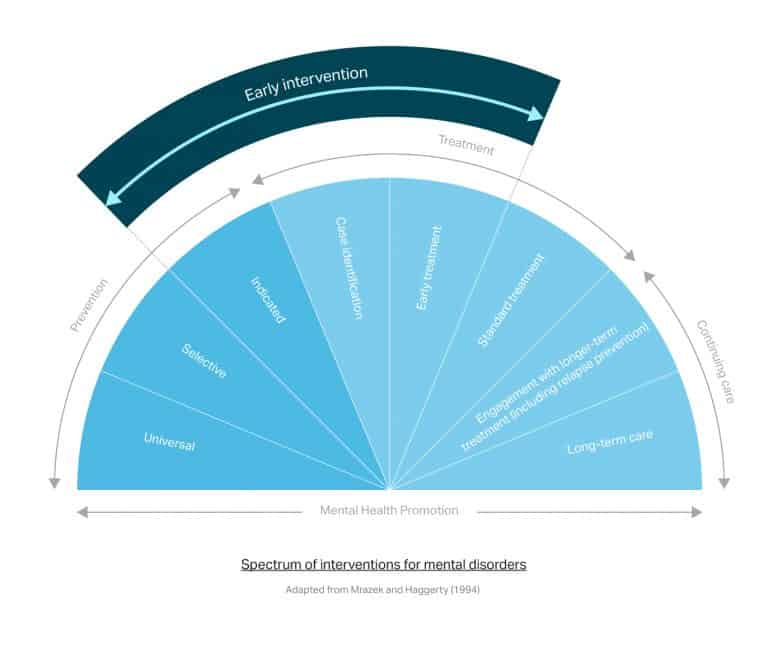Early Interventions in Mental Health
While researchers still haven’t determined the exact nature and root cause of behavioral illness, professionals can identify the clear patterns and treatment modalities that have proven results.
Early intervention is just one proven strategy that demonstrates drastically improved symptoms and quality of life for those with mental illness.
“Early intervention” is defined as the earliest possible moment that behavioral health professionals and community members can provide support and treatment to youth experiencing mental illness. It comes after prevention and before long-term care, and is often associated with adolescent youth and young adults (10 to 25 years old).
Very often, early interventions are difficult due to lack of diagnosis and proper education, denial of diagnosis and/or treatment, lack of resources, and lack of community support. However, getting treatment earlier in one’s mental health journey decreases symptoms, establishes positive habits, and is proven to result in:
-
-
- fewer hospital admissions
- shorter inpatient care
- more rapid and complete recovery
- decreased risk of relapse
- less treatment resistance
-
The Problem
Studies show that half of those who develop mental disorders will show symptoms by age 14. This period of time is crucial for brain development and often establishes the behaviors we’ll carry through the rest of our life. During this time:
-
-
- Suicide is the 3rd leading cause of death among 10 to 24 year-olds.
- Of the more than 600,000 youth placed in juvenile detention centers annually, 65 to 70% have diagnosable mental health disorders.
- Only 57% of students with disabilities exited school with a regular high school diploma in 2005-2006.
-
Statistics compiled by Mental Health America.
As the numbers show, mental wellbeing during this time is critical to avoid incarceration, graduate high school, and otherwise maintain forward progress for their mental health. Without intervention, youth with mental illness can fall into even more difficult situations where proper treatment is harder to access and maintain, exacerbating their illness and preventing long-term recovery.
Prevention
Trauma, poverty, and abuse can affect children more than adults, creating a breeding ground for mental illness, substance abuse, incarceration, and other lifelong challenges. Preventative programs that address these obstacles early can create lasting change for children and youth across demographics. Here are some examples:
-
-
- The Maryland School Wellness Partnership and the Maryland Expanded Food and Nutrition Education Program promote better nutrition and physical activity among children.
- The House of Ruth and the Maryland Network Against Domestic Violence prevent childhood and domestic abuse by promoting healthier living environments and relationship skills.
- The Maryland State Department of Education and regions like Baltimore County have initiatives in place to prevent drug abuse and promote healthy lifestyles.
- Nonprofits like YES promote self-care and empowerment through youth services.
-
Early Intervention
Early treatment begins with identifying risk factors and symptoms, diagnosing and treating the identified problems, and establishing long-term life skills. Education, awareness, family engagement, increased community support (less stigma), and equal access to mental health resources are all vital for early intervention to be a success.
Once an individual has sought support, there are specialized therapies, like CBT and DBT, that can specifically address their unique challenges. These modalities teach emotion regulation, mindfulness, distress tolerance, and interpersonal skills. Targeted coping skills help developing minds create the healthy habits and self-awareness needed to manage their mental health for decades to come.
In March 2022, The Maryland Department of Health (MDH) announced two initiatives to expand child and adolescent services, in addition to peer recovery services, to help Marylanders who are experiencing behavioral health crises. MDH will issue $17.7 million in grant funding among local behavioral health authorities statewide to help increase access to walk-in and urgent care services.
Long-Term Recovery
Together, behavioral health providers, the state, and the community are responsible for early interventions to work, and we all contribute to long-term mental illness care.
PDG is providing youth-based DBT services to address this very concern.

